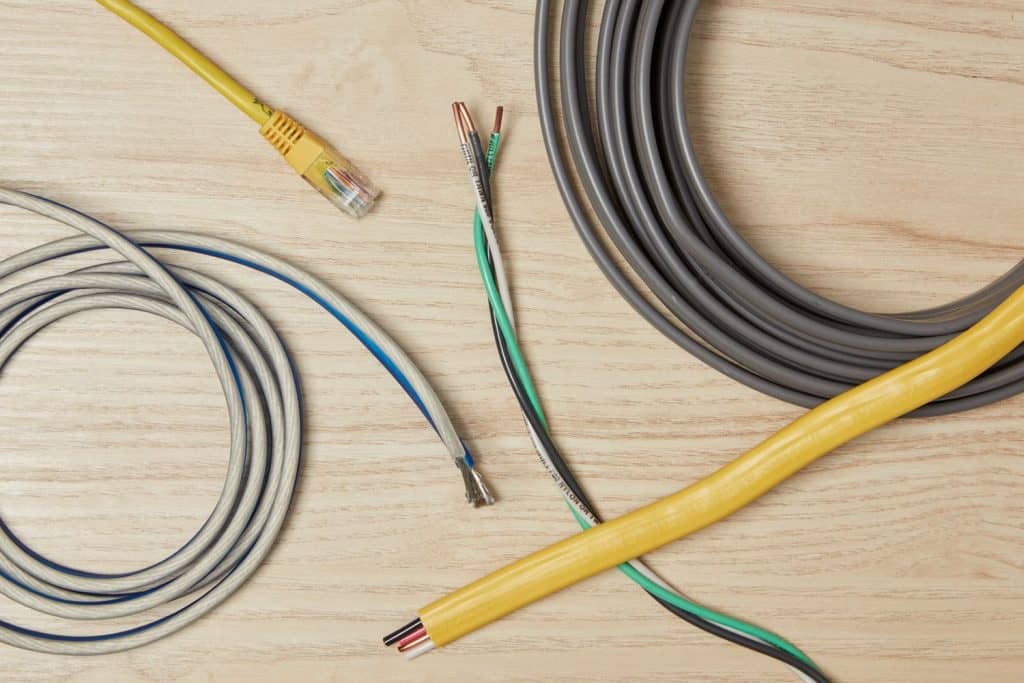
If we look around our house, almost everything is powered by electricity. Whether it is the inside of the house or the outside, we need a smooth and uninterrupted electricity supply. For this, we need to find appropriate types of wires and cables.
Usually, wires and cables are considered one and the same thing. However, they are not quite the same. Even though they carry electric current, a wire constitutes a single electrical conductor whereas a cable is a bundle of wires covered in the common sheathing. Therefore, the basic know-how of types of electrical wiring while installing new wiring around the house is essential. Other than that, wiring knowledge can tell you about circuitry.
Different Types of Wires Used in Homes:
Before we begin, let’s understand that an electrical wire is a type of conductor that conducts electricity. In household wiring, these conductors are typically made of copper or aluminum (or aluminum sheathed with copper) which are either solid metal conductors or a stranded wire. In household wiring, most wires are insulated or in other words, wrapped in a non-conductive plastic coating. However, ground wires are typically made of solid copper insulated with green sheathing but in some cases that are uninsulated (bare).
One of the most common wires used in modern households is a nonmetallic (NM) cable. This cable comprises two or more individual wires covered in plastic sheaths. NM cables typically consist of a neutral wire, a ground wire, and one or more current-carrying wires.
Instead of NM cables, you can also install individual wires within a flexible or a rigid metal or plastic tubing known as a conduit. A conduit is used when the wiring is exposed and not hidden within floors, walls, or ceilings. Conduits shouldn’t be touched as they carry higher circuit voltage. There are several wires in a home that carries low voltage and some even carry such a low voltage that they can’t electrocute you. Nevertheless, all wires should be considered dangerous until you know what types of wires you are dealing with.
1. NM Cable
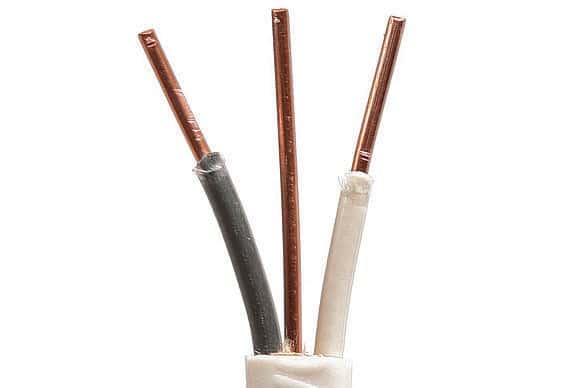
NM cables are the kind of wire used in circuits that are specifically designed to be used in interior dry locations. Usually, NM cables are built in a flattened manner so that they can run through your house and walls and floor cavities without being noticed. A modern house has almost all wiring in outlets and lighting done in NM cable. Here are the most common sizes and their amperage rating:
- 6-gauge (55-amp circuits)
- 8-gauge (40-amp circuits)
- 10-gauge (30-amp circuits)
- 12-gauge (20-amp circuits)
- 14-gauge (15-amp circuits)
Nowadays, NM cables have a color-coded sheaths, which indicate their wiring gauge:
- For 6 and 8 gauge wires, a black sheathed cable is used.
- The orange sheathing is used for 10-gauge conductors.
- Yellow sheathed NM cable means it has to be used in a 12-gauge conductor.
- For 14-gauge conductors, a white sheathed NM cable is used.
- NM cables don’t usually use grey sheathing but they are reserved for underground cables.
It is important to note that NM cables are dangerous to handle as they carry high voltage.
2. UF Cable – Underground Feeder
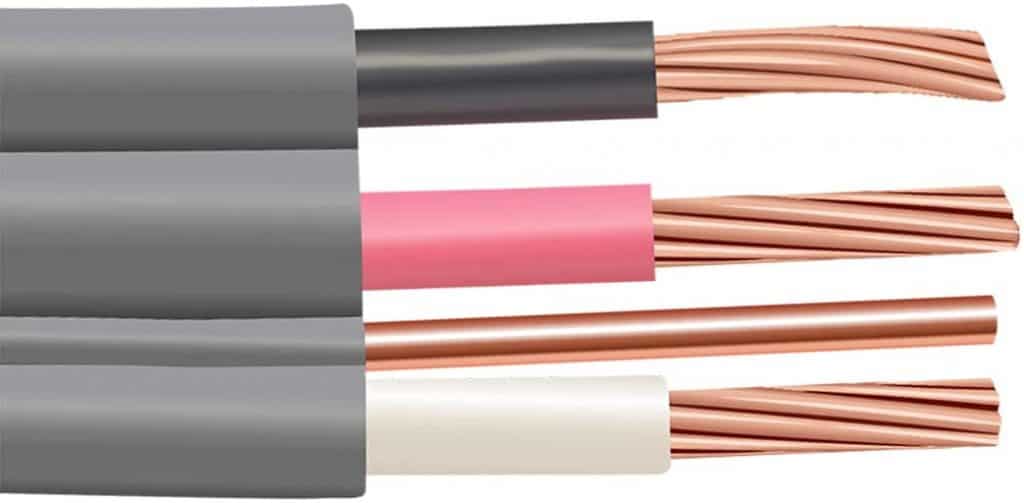
UF stands for underground feeder and this type of cable is designed to bury them underground and especially for wet locations. UF cables are usually used for powering outdoor lighting fixtures like lampposts. Like an NM cable, UF also includes insulated neutral and hot wires, and also a bare ground wire. However, the sheathing in both the wires makes them different. While the NM cable is sheathed in a separate plastic wrap, the UF cable is covered in solid plastic surrounding each wire. The UF cable is normally used in major circuit wiring. More importantly, it carries high voltage when the circuits are switched on.
3. THHN/THWN Wire
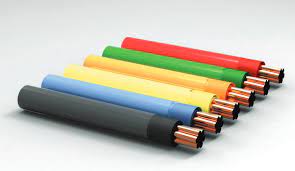
While THHN’s code is thermoplastic high heat resistant nylon, THWN’s code is thermoplastic heat and water resistant. These insulated coded wires are commonly used inside the conduit. THHN and THWN are single conductors as opposed to NM cable where more than two individual insulated conductors are grouped and covered in a plastic coating. These wires are safeguarded by plastic conduit or tubular metal instead of NM cable sheathing.
Conduits are generally used in areas such as garages, basements, and for short runs inside a house. Such wiring is also ideal for hot water heaters and garbage disposers. Both THWN and THNN have color-coded sheathings such as:
- Black, orange, and red for hotwires
- White and brown for neutral wires
- Green and yellow-green for ground wires
Please note that these wire types and circuit wires must not be handled when the circuit is switched on.
4. Low-Voltage Wire
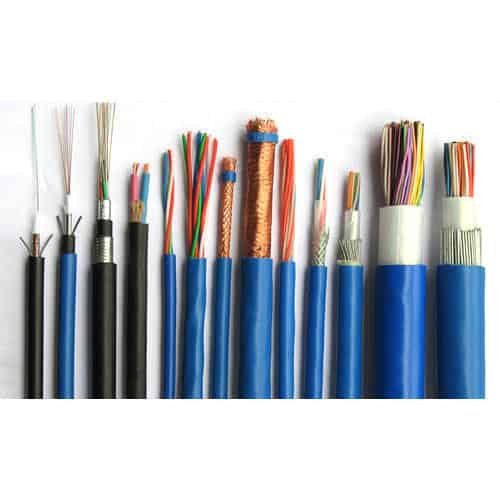
When the circuits run on less than 50 volts or less then low-voltage wiring is required. Several appliances such as sprinkler systems, landscape lighting, speaker systems, doorbells, and thermostats are run on low-voltage wires. The sizes of the wires range anywhere between 12 to 22 gauge. Low-voltage wires are usually insulated and covered in cable sheathing or are used in twisted pairs. These wires are generally very small-sized wires and must be only used for low-voltage applications. Low-voltage wires rarely shock people seriously but it is advised to switch off the devices before repairing them.
5. Phone and Data Wire
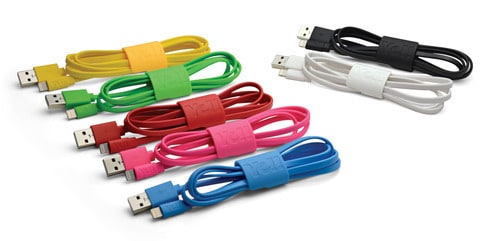
These types of wires are used for internet connections and telephones and are low-voltage wires. While the telephone cable may have between four to eight wires, category 5 or cat 5 cable, which is the most commonly used household data wire, can contain eight wires wrapped together in pairs of four. These wires are used for telephone and data transmission and offer better quality than the standard phone wire.
Even though phone and data wires carry a very small amount of voltage, they can come in contact with a house wire ( it may carry around 120-volts of power) and can be fatal. Therefore, even phone and data wires must be dealt with caution.
6. Coaxial Cable
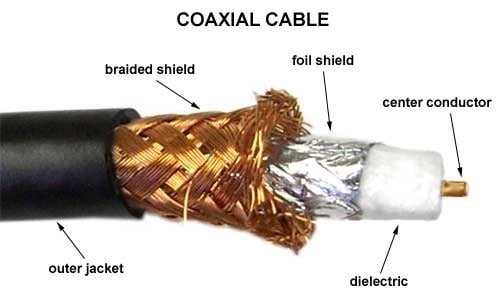
This type of wire was once regularly used in connecting television to an antenna, satellite dishes, cable service delivery, and more. However, nowadays it is less commonly used as other forms of wiring such as HDMI for data transmission have grown over the years. Coaxial cables are usually black and white in insulation colour and are perfectly round, which is a differentiating factor from NM cables. This cable’s inner conductor is wrapped in a tubular insulating layer which is further covered in braided wire. It carries a very low amount of voltage making it highly unlikely to dangerously shock anyone. However, if they come in contact with other wires they can be dangerous. So, it is recommended to not handle any bare wires.
Here are a few types of Coaxial cables:
● Hardline Coaxial or Heliax Cable
Hardline coaxial cables are also known as Heliax cables. It is a thick cable with a solid conductor at its center made from copper whereas the shield is built from either copper or silver tubing. Hardline cables are particularly used for high-frequency broadcasts. It has the ability to carry tens of hundreds of channels.
● Radiating or Leaky Coaxial Cable
Radiating or leaky coaxial cables are intentionally designed to radiate RF waves. The shield of the cable has pre-planned slots tuned for a particular RF wavelength to two-way leakage between the transmitter and the receiver. This type of cable is ideal for places where installing an antenna is not possible such as elevator shafts and underground tunnels.
● RG-6 Coaxial Cable
This cable is the most commonly used for signal transmission in both residential and commercial buildings. Built from a hard copper wire with plastic insulation wrapped by an aluminium foil and further covered in a braided shield for extra protection against external interferences. These types of wires are commonly used for audiovisual signal transmissions such as satellite TV, cable TV, and radio.
● Semi-rigid Coaxial Cable
Semi-rigid coaxial cables have an outer sheath made from solid copper and have an inner conductor. Due to its tube-like shape, it provides protection against interference. However, this cable is quite rigid and shouldn’t be bent after it is made.
● Rigid Line Coaxial Cable
It is a modified type of semi-rigid cable built with two concentric tubes or shields that offer protection from strong power signals. These cables shouldn’t be bent either and for this reason, elbows and interconnects are used when they require bending. These cables are ideal for high power signal transmission between a transmitter and in antenna
Understanding How Wires Are Sized
It is evident that there are many types of wires and when it comes to understanding types of electrical wiring, you have to understand how the wires and cables are sized. Different wires have different purposes, but with several wire types, one must know the right gauge and the right wire size.
Wires are usually sized with the help of AWG or the American Wire Gauge system. The wire gauge means that when the wire gauge number gets smaller, the wire diameter gets larger. The size of the wire influences the amount of current that can safely pass through it. Some of the common sizes of the wires: 14-, 12-, 10-, 8-, 6-, and 2-gauge wire. Also, each wire gauge can carry a certain amount of electrical current. The amperage capacity of standard changes as per the gauge.
Wire Gauge: Why is it Important?
Circuit breakers and fuses safeguard against overloading and overheating wires, but they don’t offer total protection. These devices trip or blow when the wires overhear to the point of danger. As they are not foolproof, it is important to understand the amperage rating of a circuit before plugging in too many appliances.
It is potentially dangerous to plug a device that draws more power than the wire gauge is rated for. For instance, using a 15-amp circuit to power a 20 amps heater could pose a distinct danger. If the circuit breaker fails to function correctly, the heater will draw more power than wires can handle and it can cause a fire. However, plugging in a device that requires less voltage into heavier amperage rating circuits and with heavier gauge wires is perfectly fine.
Final Thoughts
Before starting an electrical project at your house, it is important to understand different types of electrical wiring, their gauges, and their amperage rating. Based on the requirement, you must choose a wire and must be cautious in handling wires that carry a high voltage of power.
Types of Wires Generally Used in a Home FAQs :
1. How many types of wire are there?
There are basically six wire types used in residential as well as commercial applications. They are mentioned below:
1. NM Cable
2. UF Cable
3. THNN/THWN cable
4. Low-voltage wire
5. Phone and Data Wire
6. Coaxial cable
2. What are the 5 good electrical conductors?
Copper, gold, silver, steel, aluminum, and brass are some of the best electrical conductors. From this list, copper, gold, and silver are the most highly conductive metals. This list also includes alloys because the shape and the size of a substance can affect its conductivity.
3. How are wires classified?
An electrical cable can be classified by the number of conductors it’s built from. First, the twisted-pair cable, which is built from two conductors insulated and twisted together. It is ideal for signal transmission. Then there are multi-conductor cables consisting of two or more conductors. It is ideal for home applications.
4. What is the difference between wires and cables?
Usually, wires and cables are considered one and the same thing. However, they are not quite the same. Even though they carry electric current, a wire constitutes a single electrical conductor whereas a cable is a bundle of wires covered in the common sheathing.






